Mahameghavahana dynasty
The Mahameghavahana dynasty (Mahā-Mēgha-Vāhana, 2nd or 1st century BC to early 4nd century CE[1][2]) was an ancient ruling dynasty of Kalinga after the decline of the Maurya Empire. In the first century B.C., Mahameghavahana, a king of Chedirastra (or Cetarattha, i.e., kingdom of the Chedis)[3] conquered Kalinga and Kosala. During the reign of Kharavela, the third king of Mahameghavahana dynasty, South Kosala became an integral part of the kingdom. He patronised Jainism, but did not discriminate against other religions.[4][5] He is known by his Hathigumpha inscription.
Maha-Meghavahana Dynasty Mahāmēghabāhana | |||||||||
|---|---|---|---|---|---|---|---|---|---|
| 2nd or 1st century BC–4nd century CE | |||||||||
| Religion | Jainism | ||||||||
| Government | Monarchy | ||||||||
| Historical era | Classical India | ||||||||
• Established | 2nd or 1st century BC | ||||||||
• Disestablished | 4nd century CE | ||||||||
| |||||||||
| Outline of South Asian history | ||||||||||||||||||||||||||||||||||||||||||||
|---|---|---|---|---|---|---|---|---|---|---|---|---|---|---|---|---|---|---|---|---|---|---|---|---|---|---|---|---|---|---|---|---|---|---|---|---|---|---|---|---|---|---|---|---|
_without_national_boundaries.svg.png) | ||||||||||||||||||||||||||||||||||||||||||||
|
Palaeolithic (2,500,000–250,000 BC) |
||||||||||||||||||||||||||||||||||||||||||||
|
Neolithic (10,800–3300 BC)
|
||||||||||||||||||||||||||||||||||||||||||||
|
Chalcolithic (3500–1500 BC)
|
||||||||||||||||||||||||||||||||||||||||||||
|
Bronze Age (3300–1300 BC)
|
||||||||||||||||||||||||||||||||||||||||||||
|
Iron Age (1500–200 BC)
|
||||||||||||||||||||||||||||||||||||||||||||
|
Middle Kingdoms (230 BC – AD 1206) |
||||||||||||||||||||||||||||||||||||||||||||
|
Late medieval period (1206–1526)
|
||||||||||||||||||||||||||||||||||||||||||||
|
Early modern period (1526–1858)
|
||||||||||||||||||||||||||||||||||||||||||||
|
Colonial states (1510–1961)
|
||||||||||||||||||||||||||||||||||||||||||||
|
Periods of Sri Lanka
|
||||||||||||||||||||||||||||||||||||||||||||
|
Specialised histories |
||||||||||||||||||||||||||||||||||||||||||||
South Kosala was later conquered by Gautamiputra Satakarni of the Satavahana dynasty in the early part of the 2nd century CE and remained in their possession up to the second half of the 2nd century CE. It was during the second and third century CE, the Meghas or Meghavahanas reappeared in the political scene and regained their suzerainty over South Kosala. Samudragupta during his daksinapatha expedition, defeated Mahendra of Kosala who probably belonged to the Megha dynasty. As a result, the South Kosala during the fourth century A.D, became a part of the Gupta empire.[1][6]
The Sada dynasty who ruled form Amaravathi region in their inscription from Guntapalli describe themselves as Maharaja of Kalinga Mahisaka countries belonging to Mahameghavahana family.[7]
Architecture
Udayagiri and Khandagiri Caves is the most prominent example of Mahameghavahana dynasty work. These caves were built in 2nd century BCE during the rule of King Kharavela. Udayagiri means "Sunrise Hill" and has 18 caves while Khandagiri has 15 caves. The Hathigumpha cave ("Elephant Cave") has the Hathigumpha inscription, written by Raja Kharavela, the king of Kalinga in India, during the 2nd century BCE. The Hathigumpha inscription consists of seventeen lines incised in deep cut Brahmi letters starting with Jain Namokar Mantra. In Udayagiri, Hathigumpha (cave 14) and Ganeshagumpha (cave 10) are especially well known due to art treasures of their sculptures and reliefs as well as due to their historical importance. Rani ka Naur (Queen's Palace cave, cave 1) is also an extensively carved cave and elaborately embellished with sculptural friezes. Khandagiri offers a fine view back over Bhubaneswar from its summit. The Ananta cave (cave 3) depicts carved figures of women, elephants, athletes, and geese carrying flowers.
 Udayagiri
Udayagiri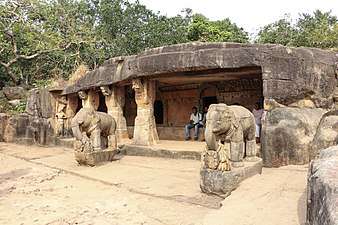 Ganesha Gumpha (cave no-10), Udayagiri
Ganesha Gumpha (cave no-10), Udayagiri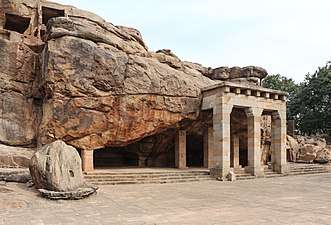 Hathi Gumpha (cave no-14), Udayagiri
Hathi Gumpha (cave no-14), Udayagiri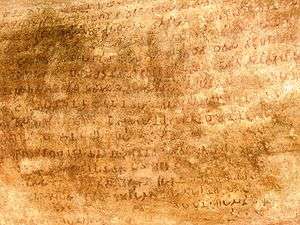
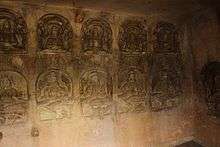 Carving of Tirthankaras & Goddesses inside Navamuni Gumpha
Carving of Tirthankaras & Goddesses inside Navamuni Gumpha- Udaygiri Stone Caves
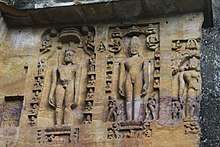 Carving of Jain Tirthanakars
Carving of Jain Tirthanakars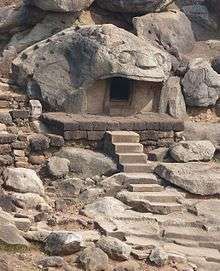 Sarpa Gumpha (cave no-13), Udayagiri
Sarpa Gumpha (cave no-13), Udayagiri
References
- Sahu, J. K. (1977). "The Meghas of Kosala". Proceedings of the Indian History Congress. 38: 49–54. ISSN 2249-1937. JSTOR 44139050.
- Sahu, J.K. (1977). "The Meghas of Kosala" (PDF). shodhganga.
- L Bhagawandas Gandhi (1927). Tribes In Ancient India.
- Hampa Nagarajaiah (1999). A History of the Early Ganga Monarchy and Jainism. Ankita Pustaka. p. 10. ISBN 978-81-87321-16-3.
- Kailash Chand Jain (2010). History of Jainism. D. K. Print World (P) Limited. p. 437. ISBN 978-81-246-0547-9.
- Sahu, J.K. "The Meghas of Kosala" (PDF). shodhganga.
- Shimada, Akira (9 November 2012). Early Buddhist Architecture in Context: The Great St?pa at Amar?vat? (ca. 300 BCE-300 CE). BRILL. ISBN 978-90-04-23283-9.